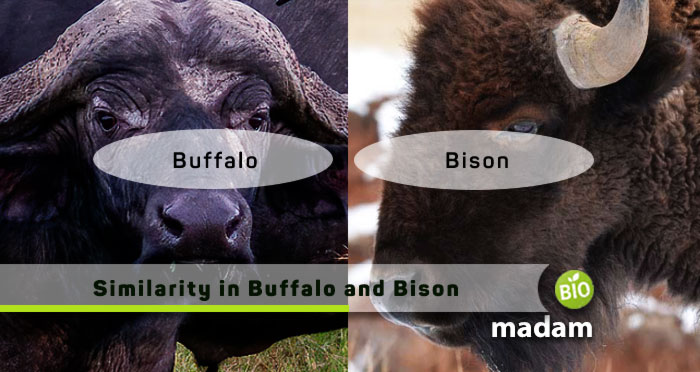If you spotted a buffalo that you later got to know was a bison, you are not the only one. Buffalos and bison look so incredibly similar that many people confuse one for the other. However, there are a few features that distinguish them from one another as they contribute to different types of biodiversity. When you observe them considering those characteristics, you will be able to tell them apart easily. Now that you know buffalo and bison are not the same, let’s tell you how they differ.
Appearance
Bison typically appear larger than buffalos, but it depends on the species. Bison have large shoulders and heads compared to buffalos. However, their horns are shorter and less curved than buffalos. Bison also have larger humps on their shoulders and goat-like beards. Their coat is slightly thicker than buffalos which they shed during spring and summer.
Size
As we already mentioned, bison are typically larger than buffalos. They not only look larger in structure but also weigh more than buffalos. Buffalos weigh between 1,300 and 2,000 lbs, while bison weigh 2,200 and 2,500 lbs. Moreover, they also vary in height, giving bison a larger appearance than buffalos. The average height for buffalos is 4 to 4.5 feet, whereas bison are 5 to 6 feet tall. Their large size helps protect them from many environmental dangers within the community and ecosystem.

Horns
Horns are the most prominent distinguishing factor between buffalos and bison. Bison have smaller horns of up to 2 feet. Meanwhile, buffalo horns may be as big as 6 feet and curl up 2 to 3 feet more.
Speed
Being big animals, buffalos and bison are not as fast as many other organisms. Buffalos have a speed of 30 mph, while bison move at 35 mph. They may use it as a defense mechanism depending on the danger.
Attacking Mechanism
Buffalos use their long horns to gore enemies, while bison may ram their enemies using their horns. Their large size enables them to trample on any danger or attack another organism when needed, thus are a part of food chains, and ultimately food webs.
Habitat
Africa and Asia are favorable habitats to buffalos. At the same time, bison deal with cold weather and freezing climate in North America and Europe.

The Bottom Line
Buffalos and bison look quite similar to each other when you do not know the basic differences in their shape and structure. Bison are typically larger than buffalos and also weigh more. Bison have humps on their shoulders that distinguish them from buffalos. Despite being smaller, buffalos possess larger horns, as big as 6 feet, while bison horns are 2 feet long. You can identify them in your biomes and ecosystems through these differential features.
FAQs
Why do they call bison buffalo?
Due to a similar appearance, there was not much distinction in the word used for each species. The French used “bœuf” for bison when they saw them in the USA for the first time. “Bœuf” translates to “true buffalo,” as bison resembled buffalos, leading to the use of “buffalo” for bison.
Is bison and buffalo meat the same thing?
Bison and buffalos are not specifically distinguished in the meat market. Most people will look for beef, and both these organisms are a source of beef used in foods. Even most “buffalo burgers” are made of bison meat, providing enough carbs in total calories.
Does Yellowstone have bison or buffalo?
Yellowstone is home to bison in prehistoric times, and they still live there. You might be surprised to know that Yellowstone bison make up the largest bison population in the US.
Is buffalo male or female?
Buffalo is not gender-specific and may refer to male and female buffalos. Male buffalos are referred to as bulls, while the others are female buffalos and calves.

Hello, I would like to introduce myself to you! I am Chelsea Rogers, an experienced blog writer for science articles, holding an MPhil degree. My enthusiasm to grab the best knowledge, let it relate to botany, zoology, or any other science branch. Read my articles & let me wait for your words s in the comment section.

